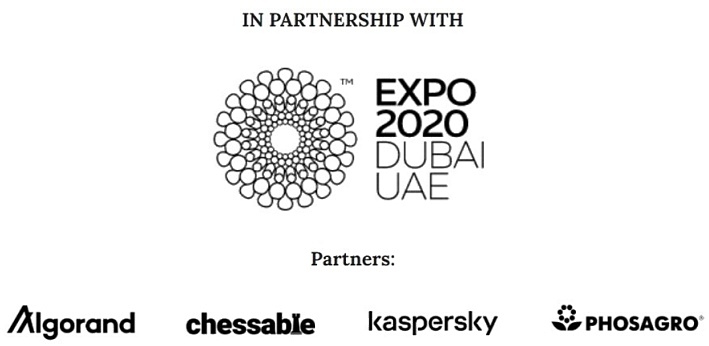The unique 14-game format of the 2021 FIDE World Championship means that there is no easy spot to stop and play the game of drawing halfway mark conclusions. After game 7, we’ll have had a lopsided half, with challenger Ian ‘Nepo’ Nepomniachtchi enjoying an extra game with the white pieces and advantage of the first move, and we would be comparing the action to the coming mirror version.
If we want to balance colours out, then we need to choose game 6 or 8. Since we have so many pundits assembled, we can expect retrospective assessments … constantly. Game 8 is probably the best time to get a symmetric look back, as it will mark a full set of three blocks of play, 3-2-3. Since the match is two games longer than normal, rest days have been trimmed down to keep the event the same length, so we need to wait until after game 8 to have seen each player try this new segment with an extra white out of the trio of games.
More equal
Besides the halfway mark, any rest day is a natural opportunity to dissect the preceding action. We may have had five draws, but there are plenty of ways to extract fuzzy information from what we’ve seen, to support gut feelings that, even if the score is winless and deadlocked, one of the players is ‘ahead’.
Although it’s too early to investigate all the nuances, the word on the street, or in the Dubai Exhibition Centre, is that Team Nepomniachtchi and their supporters are feeling like the challenger has an abstract lead after five games, and it isn’t hard to find discussions in print or online that agree.
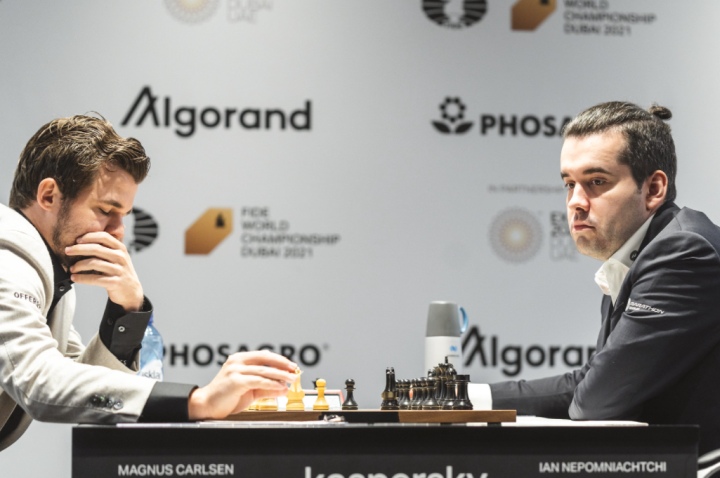
The two previous games have reversed the early sense that champion Magnus Carlsen has been the better prepared of the two, and in the fifth game Nepo achieved the holy grail of deeper preparation, an advantage on the clock, and a safe but dangerous superiority on the board.
War of nerves
Weighing up these not entirely tangible victories, there is also the tricky equation of game 2, where Carlsen clearly detonated a dangerous surprise weapon, but his childhood nemesis of an opponent managed to turn the tables and was the only one who had serious winning chances.
The games have been tense and hard-fought, if peaceful in the end. At the last post-game press conference, the champion was visibly weary but happy, and the challenger appeared distracted and disappointed.
The trickiest part of tallying up these mostly psychological points, is assessing their impact. Is having a few more shots on goal uplifting, or is keeping a clean sheet? Magnus has a clear track record of becoming hugely frustrated when starved of wins, Ian is widely reckoned to be a moody player. Before the match, Carlsen said his opponent’s biggest flaw was probably losing form when disappointed, whether by a loss, or missed opportunities. So – are they both annoyed so far?
Perhaps new Chessable CEO Geert van der Velde found the key metric, suggesting: ‘who is getting in the other’s head?’. This makes it feel like the real duel boils down to stamina; how many frustrating draws can Magnus take, and can Ian shrug off any sort of disappointment and continue to follow a match strategy that might be rubbing him the wrong way? Only hindsight knows.
Game six
Today’s game featured the usual rituals but with twists. Carlsen, who has been chronically late to appear after the daily starting summons from Master of Ceremonies Maurice Ashley, took his seat on stage a few minutes before the start of play, which caused a bit of confusion. Ashley launched into the introduction of the players at once since one was already visible.
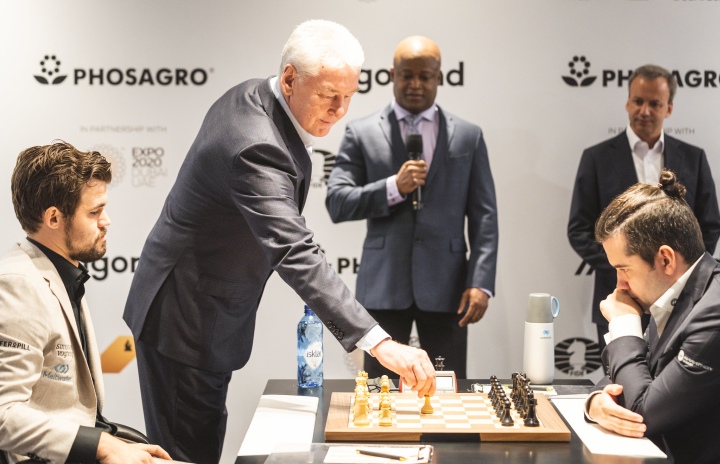
Today’s trio for the ceremonial making of the first move was FIDE President Arkady Dvorkovich, Natalya Komarova, Governor of the autonomous region Khanty-Mansi, and the Mayor of Moscow, Sergey Sobyanin, who actually played the move. The players returned to the Catalan Opening, which produced the most dramatic clash of the match so far, in game two.
Phase one
Carlsen was again the first to vary, and once more offered to sacrifice a pawn in return for the more active pieces. Nepo began thinking very early, but his decisions in the opening phase of the game indicated that he might have been surprised but was solving the problems posed confidently at the board. First, the challenger declined the offered pawn, and after a longer pause on move 10, appeared to work out a long-term plan.
From here, the roles were reversed, with Carlsen grim-faced and immersed in his calculations, burning clock time. Expert commentators were impressed by the challenger’s handling of the position and felt his combination of care and accuracy had given him a very pleasant position. “I think we can say Ian did comfortably well in the opening, mostly through good play,” said previous world title challenger, US grandmaster (GM) Fabiano Caruana, implying that the challenger had been out of his preparation early.
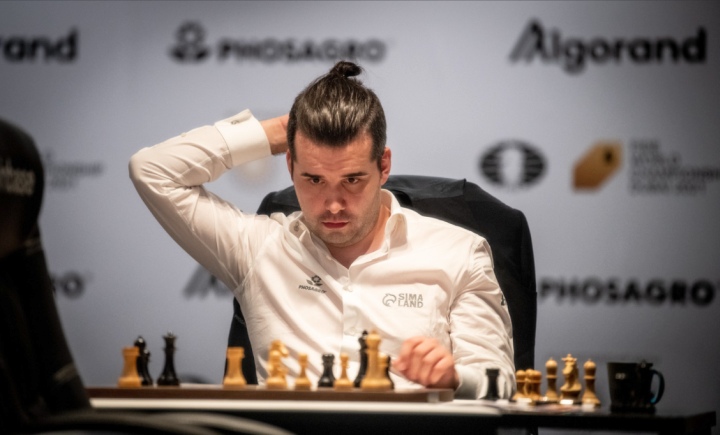
On his 17th move Nepomniachtchi rejected the exchange of queens, hinting that he not only felt comfortable in the position, but was interested in a more complicated game. Experts assessed the chances as equal, but the position was not necessarily dull.
Further reflection
As many of the star-studded commentary teams, both in Dubai and online, used the players’ long thinking time to do their own deeper dives, the mood began to shift, with a new consensus that Carlsen was generating the kind of micro-advantages that became his trademark strength, an ability to convert nearly invisible pressure into smooth victories. Although computer ‘commentators’ continued to assess the position as in total balance, human authorities began to scent excitement.
The challenger found a bold continuation, offering a material imbalance to stay active, and the champion found himself seriously short of time for the first time in the match, with under 10 minutes to work out his last 11 moves, or forfeit the game. The human factors were now in focus, with nerves and time pressure providing dangers that computers insisted didn’t exist, as both players appeared willing to risk a loss to create complications.
Jangling nerves
The challenger was the first to misplay the position, though when the climax arrived around move 31, the game would flare up so violently that handling it correctly was unlikely for either. Nepos’s miscue allowed Carlsen an opportunity to launch a powerful surprise attack, but with the champion having only a few minutes for his last eight moves, he immediately returned the favour with a shaky 33rd, squandering a large but well hidden winning chance, and offering Nepomniachtchi a chance to create threats of his own.
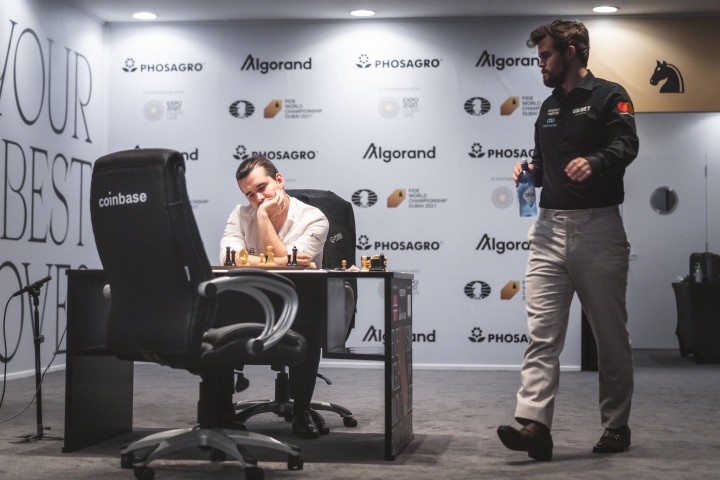
The chances fluctuated as both players had to negotiate the sudden storm of complications with their time running out. Carlsen had one golden opportunity to snatch victory, but in the necessary rush to make his 40th move, he let this slip.
After move 40, calm returned, as each player gets an additional hour added to their clocks, to reach move 60. Despite the mutual heroics and dramatics, experts predicted that the best efforts of both playe were likely to end yet again … in a draw.
More drama
A hasty 52 move by the sometimes impulsive challenger puzzled commentators, who felt that Carlsen once again gained the upper hand and a safe position, though his clock continued to be a distraction in the second time control. After this, experts forecast a long, difficult defensive slog for Nepomniachtchi. The challenger’s trainer, GM Vladimir Potkin, was optimistic, saying he was “pretty confident” his man would survive the pressure since his pieces remained active.
After move 60, the players got their final injection of clock time – 15 minutes – as well as a supplemental 30 seconds every time they make a move. As the players entered this final stage, Carlsen moved ahead on the clock for the first time in the game, with a tense and time troubled finale looming.
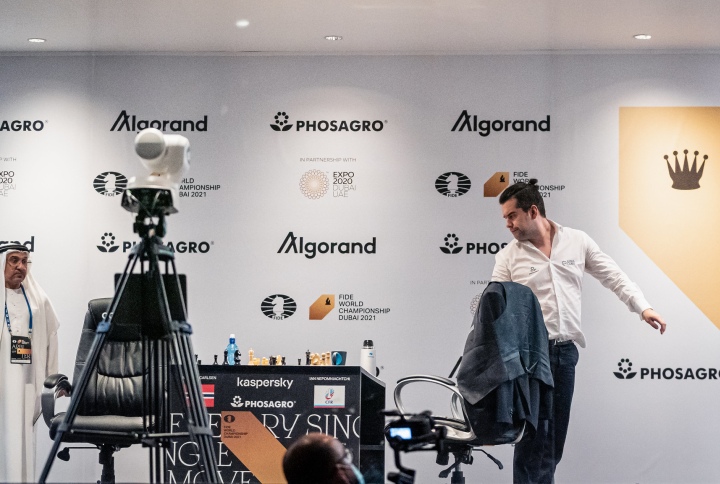
A new nervous peak arrived as Carlsen ran his clock down to near zero calculating his 75th move, but then unleashed a combination that transformed the material balance yet again, achieving another favourable ending that would allow the dance of fraying nerves and hurried moves to continue indefinitely.
The game broke the record for the longest game in a world championship, previously set in 1978 in Baguio City, Philippines, when challenger Viktor Korchnoi stalemated title-holder Anatoly Karpov on the 124th move.
The practical difficulties of preventing Carlsen from methodically advancing his pawns towards promotion proved insurmountable for Nepomniachtchi, especially when added to the remorseless pressure of the clock, which allowed no more lengthy thinking.
Carlsen continued to have a slight edge and gradually nurtured a tiny superiority into a long torture session where Nepomniachtchi eventually needed extreme stamina and vigilance to withstand the pressure. After Carlsen’s 136th move, it was clear that the Norwegian champion would shelter his king and usher his pawns into promotion, and the challenger resigned.
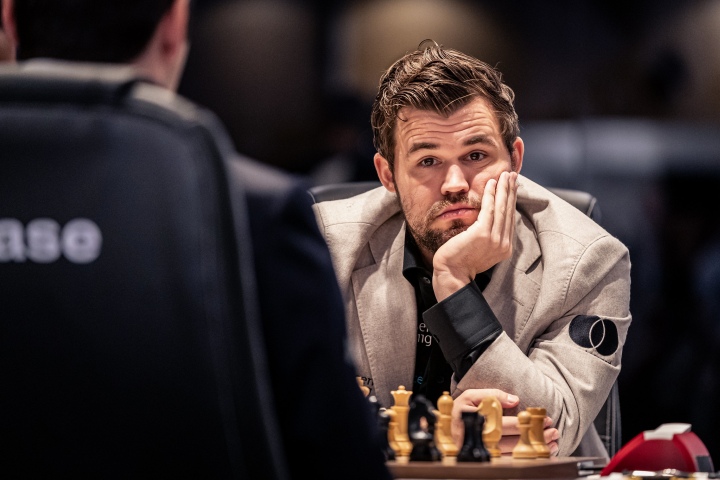
Summary
As in game two, a Carlsen white resulted in a full-blooded fight with fluctuating chances, and this time both players were prepared to take risks to keep the game alive. In a nerve-wracking scramble to make it to move 40 without losing by exceeding the time limit, the champion missed the clearest winning chance of the duel so far on the last move of the first session.
The players briefly discussed the game before moving on to the post-game press conference and seemed to agree that the objective result should have been a draw. As Carlsen exited the playing area, he said: “I’m obviously elated. I was probably a bit more patient.”
In the press conference, Carlsen confessed that his last few moves in the first time control were ‘mostly guessing’. Nepomniachtchi said that he wanted to play for more than a draw after the opening phase but that the game had been roughly balanced until the second time control, when things ‘started to go a bit wrong’.
Asked if a long win meant extra pleasure, the champion simply said ‘Yes!’. The challenger was asked how one bounced back from such a game and replied, still showing confidence: ‘Hopefully in style!’
The match continues on 4 December, with challenger Nepomniachtchi having the advantage of the white pieces and first move.

FACT SHEET, Game 6, FIDE World Championship Dubai 2021:
White: Magnus Carlsen
Black: Ian Nepomniachtchi
Result: 1-0
Match score: 3½-2½
Game length: 136 moves
Opening: Catalan Opening
Trivia: The sixth game of world championship matches has a history of being dramatic and unusually decisive. Today’s game was the longest ever played in a title match.
Text: Jonathan Tisdall, Press Officer press@fide.com
Photo: Niki Riga, Eric Rosen and David Llada
Official website of FIDE World Championship Dubai 2021
